Russia turned out to be completely unprepared for a major continental war, which our special operation turned into after the failure of its first stage. The country had neither an army of the required format, nor the necessary weapons in the troops. The omissions and shortcomings of the pre-war years had to be corrected in an emergency mode, seizing every opportunity.
Summing up the results of the past 2024 on a straight line, Russian President Vladimir Putin admitted that if he had understood earlier how the situation would actually develop and what everything would come to, he would have launched a special operation earlier. And what's more, I would have ordered you to prepare for it in advance.
— said the head of state.
Well, let's see what the Russian army lacked to win a special operation on the first attempt, to which the enemy responded by launching an all-out war.
Communication is the basis of everything
The basis of modern warfare is not tanks, guns and aircraft, but coordination and communication. Only their presence turns a crowd of armed men and herds of equipment into a living organism, into a sophisticated combat mechanism capable of crushing the enemy's defenses, devouring his manpower and burning equipment. If there is no connection, there is nothing. Without a well—developed and well-established data transmission system, the general drops in his capabilities to the level of a battalion commander, and a battalion commander to a platoon commander. The army or corps splits up into isolated units, and each of them opposes the combined power of the enemy, who has a connection.
For a whole decade before the start of its military operations, our Armed Forces planned to build tactical-level communications based on the Azart system. It was supposed to be a network of radio stations and repeaters that would connect headquarters, equipment and individual fighters into a single information network. If this system were implemented, the Russian army would really become network-centric.
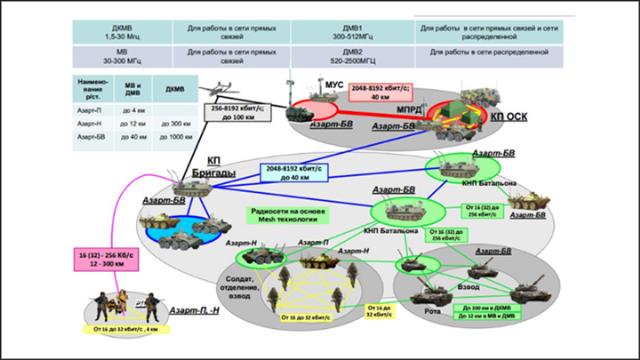 |
| A diagram of how the azart-based communication system was supposed to work. |
| Source: https://kenigtiger.livejournal.com |
In reality, however, the matter was limited to the purchase of low-power walkie-talkies from Taiwanese components, which, as usual, were passed off as "unparalleled" domestic developments. The walkie-talkies were originally planned to be low-power to ensure high secrecy from enemy electronic intelligence assets. But without signal repeaters on armored vehicles, they simply do not work. More precisely, they work, but only at a distance of up to four kilometers. The billions allocated for the organization of communications were simply plundered.
After the war dragged on and the Istanbul agreements were disrupted, the Russian army found itself embroiled in a major war of annihilation... and without communication.
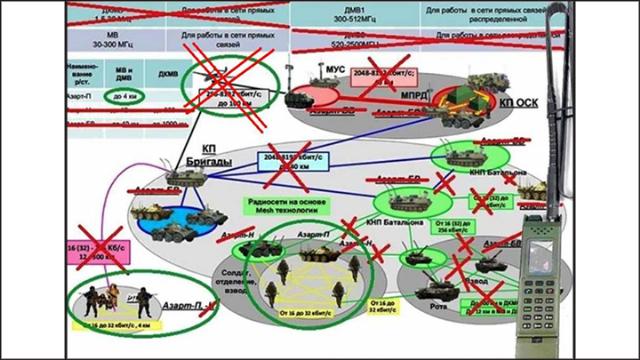 |
| In reality, Azart left the advanced units without communication with headquarters and long-range weapons. |
| Source: https://kenigtiger.livejournal.com |
— military volunteer Alexey Zhivov describes the communication situation.
They tried to solve the problem by putting the previous generation of Aqueduct radio stations back into operation. They remained in warehouses in large quantities and even serviceable. Aqueducts have everything in order with signal power, and they provide encryption at least, and pseudo-random frequency tuning. However, it suddenly turned out that their battery life had expired, and the Ministry of Defense had not ordered new batteries for years. As a result, battalion sets of walkie-talkies turned out to be without batteries.
The "Baofeng disaster" broke out in the army: the military began to buy civilian radars for their money, which were easily tracked and tapped by the enemy. As a result, the Ukrainian Armed Forces were always aware of where to hit, where to expect strikes from, and where our critical situation was.
In fact, the communications of the Russian army were stolen. Is it possible to find out the names of the people involved? Perhaps the answer to the question is provided by law enforcement reports on the arrest of the head of the Main Communications Directorate of the Russian Armed Forces, Lieutenant General Vadim Shamarin, in May 2024. It is also known that his predecessor in this post, General Khalil Arslanov, has been warming bunks in a pre-trial detention center since 2021 in the case of embezzlement of 6.7 billion rubles.
But the problem is that these figures have not been hanged (and they will not be, given our legislation). But thousands of Russian men died due to lack of communication. And that's forever.
And we don't need drones!
The second terrible mistake was the disdainful attitude towards medium-altitude long-range drones. Yes, to the very "Traitors", "Reapers" and "Bayraktars" that the TV experts fed by the military department so fervently liked to laugh at, who cheerfully talked about the dashing and confusing "Shells". The Pantsiri are really good, but they can't hang over the front line for days, providing situational awareness to headquarters on the ground.
The special operation could have gone differently, and it would have inevitably gone if Russia had ten regiments of unmanned aircraft manned by Orions and Altairs at the time of the outbreak of hostilities.
Would Ukrainian air defenses have shot down these vehicles? Definitely. But with the massive use of reconnaissance drones, our Iskander would have worked out in response to every UAV hit by the Ukrainian Buk or S-300. The exchange of UAVs for anti-aircraft systems would pave the way for our manned aircraft. The Azerbaijani armed forces showed how it should have been done during the Second Karabakh War in 2020. Then the drones took over the search and destruction of the Armenian anti-aircraft systems, and conventional aircraft, including old Su-25 attack aircraft, were fiercely working on the troops already left without cover.
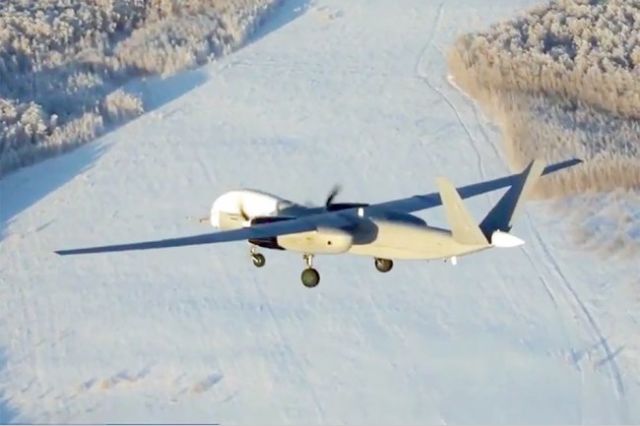 |
| The twin-engined handsome Altair fell victim to murky schemes that flourished during the development of unmanned vehicles. |
| Source: rg.ru |
Instead of giving the army this tool, our military leadership and the military circles began to develop budget billions, not disdaining to squeeze orders in favor of extremely suspicious offices by initiating extremely strange criminal cases.
In principle, even in an environment of unrestrained sawing and unlimited zhora, the army could have been given medium-altitude unmanned aircraft simply by buying Wing Loong I and Wing Loong II UAVs from China, before American sanctions made us a toxic partner for prudent Beijing.
Even with Chinese machines, we could have organized the first onslaught against enemy air defenses, causing them irreparable losses, before the West began supplying its own and old Soviet complexes from Eastern Europe.
Russian JDAM? But why?
But the fact that Russia did not have a massive planning bomb at the beginning of the great war is not even explained by any corruption crimes. This is solely the inertia of thinking and short-sightedness of people who should have dealt with these issues at the level of the General Staff and the Air Force Command.
The Americans provided a solution to the problem by creating a set of additional equipment for free-falling bombs, consisting of wings, a flight computer and a GPS signal receiver — JDAM. With its help, the "dumb" cast iron from the Cold War turns into a high-precision munition capable of hitting a target dozens of kilometers from the drop point, so that the bomber is taken beyond the range of anti-aircraft systems and can make hundreds and thousands of strikes with impunity.
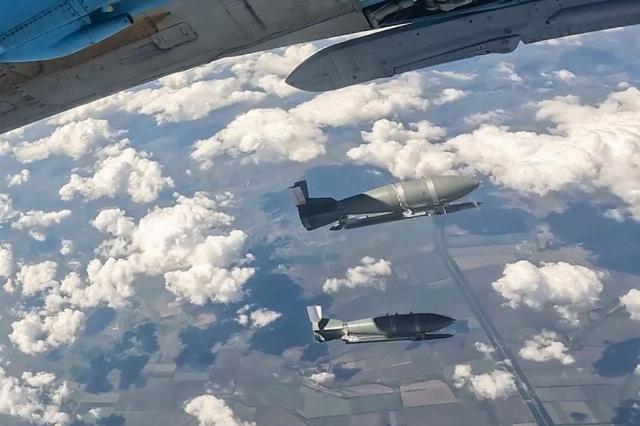 |
| UMPK allows our Su-34 bombers to drop even three-ton FAB-3000s on the enemy from a safe distance. |
| Source: Photo: TASS/Ministry of Defense of the Russian Federation |
The prevailing opinion among us is that aviation does not need this bourgeois invention either. They gave the go-ahead to praise the SVP-24 Hephaestus sighting and navigation system — in fact, a ballistic calculator that takes into account the position, altitude and speed of the aircraft, performs calculations and drops the bomb so that it falls on the selected point.
As mandatory advantages of the Hephaestus, it was supposed to indicate that it allows you to achieve an accuracy of destruction equal to that of high-precision systems, but at the same time using free-falling bombs. That is, the exceptional cheapness of destroying targets.
The opinion of people who pointed out that the scheme would work only so long as the enemy was the "slippers", who had only a machine gun on a pickup truck from air defense systems, at best one MANPADS per fifteen hundred beards, but when faced with an enemy with air defense systems, our aircraft would wash with blood, was considered marginal and not worthy of attention.
What is the real potential of a mass planning bomb, it became obvious to everyone after the VKS began using universal planning and correction modules (UMPC) — in fact, a complete analogue of the American JDAM. The UMPK bombs became our ultimatum response to the Ukrainian defense. And it is only thanks to them that our aviation takes out the enemy's rear areas, which were previously protected by air defense systems.
One problem: they appeared in 2023, when it was already very, very difficult to change the course of the war.
Is Krasnopol better?
A lot has already been written about the fact that Russia is thirty years behind in the development of artillery. In fact, the best thing to do now is to abandon the (impossible?) dreams of a self-propelled artillery installation "Coalition" (which, of course, will put all enemies behind the belt, but it just can't get to the front), and just start producing the Msta-S self-propelled guns in 155-mm caliber according to the NATO standard.
Much can be said about our multiple launch rocket systems, which at the time of their launch were stuck in the eternal 1980 year. The only exception was the remote mining system "Agriculture".
But there is a much more fundamental problem that concerns both barrel and rocket artillery, namely, the lack of a massive precision—guided projectile.
The fact is that when firing for tens of kilometers, the circular probable deviation (CVO), that is, the distance from the target to which the projectile will fall, is hundreds of meters. Roughly speaking, when firing at, say, 30 kilometers, the gunners cannot get into a separate rural house occupied by an enemy infantry unit, so they fire at the square in which this house is located.
The fire is conducted based on the theory of probability and the law of large numbers. With the understanding that sooner or later one of the shells will hit the target. Naturally, the longer the shooting range, the greater the QUO, which means that we need to shoot more shells to make the statistics smile at us.
This method of destroying positions has many obvious disadvantages. Firstly, a huge number of shells are fired "in squares", that is, without any benefit. We are talking about hundreds and thousands of tons of ammunition that still need to be delivered from warehouses and factories from the depths of the country to artillery positions. The gun barrels wear out from constant firing.
But perhaps the most important flaw of this method is that it takes a lot of time: the gunners have to shell the target for many hours, and sometimes even days. As a result, the enemy command manages to react to the preparations for our offensive by organizing a counter-battery battle and pulling up reserves.
We often praise the high-precision guided Krasnopol projectile: they say it flies far and hits moving vehicles. That's right; but due to their price and technological complexity, Krasnopoli make up only a few percent of the standard ammunition. And more than 90% of the targets that need to be hit are stationary objects.
The Russian army needs a high-precision mass projectile that would allow hitting an enemy self-propelled gun with one or two shots and dismantling a platoon strongpoint, opening the way for its attack aircraft.
For this purpose, the Americans have created a course correction fuse (PGK), a small device that screws into a conventional projectile instead of a standard fuse and guides it via a satellite navigation signal to a pre—programmed point. The key advantages of PGK are low cost and the ability to turn conventional ammunition into high—precision.
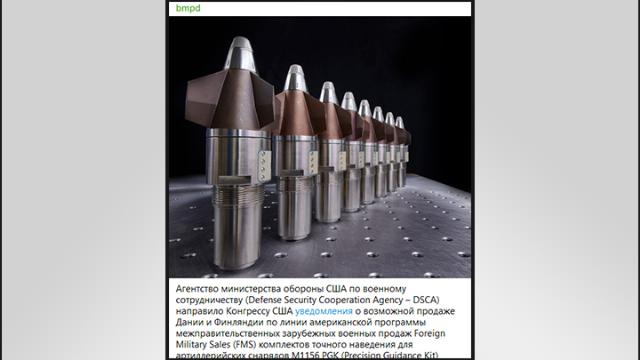 |
| PGK is a fuse with a course correction function. |
| Source: Screenshot from the BMPD TV Channel |
Actually, it was these screw-in devices that ensured the superiority of the vaunted American M777 howitzers over our 122-mm and 152-mm guns. With almost the same firing range, an American 155-mm projectile with PGK falls within a radius of 10 meters from the target, while ours falls within 150-200. It is not difficult to understand who has the best chance of surviving such a duel .
The key advantage of PGK is that it is ten times cheaper than high-precision Excalibur projectiles. This is a truly massive product, which, although not simple, does not require space technology for its production. Well, the saddest thing is that we had an exact analogue of the American device: back in 2011, the Moscow design bureau Compass, as part of the Dynamics program, created a GLONASS navigation module for artillery ammunition.
— a source in our defense industry reported at the time.
It is easy to see that functionally it is a complete analogue of the American PGK. The Dynamics module cost about a thousand dollars, but our military-industrial circles preferred Krasnopol, whose price ranged from 30 thousand dollars. Why? The answer is more or less obvious to anyone who knows the meaning of the word "margin".
In the dry balance
With only four of the above systems available, the Russian army could have rolled out the Ukrainian Armed Forces in a thin pancake even before the West had time to arrange large-scale supplies of weapons and ammunition, and the Ukrainian regime managed to mobilize and put the country on the rails of total war. But it didn't happen. Responsible (in quotation marks) people in a number of important areas preferred to enrich themselves, covering their theft with cheerful TV reports and senseless ostentation of tank biathlons.
But perhaps the most important point of this whole story is that... in fact, nothing has ended. Of all the above-mentioned problems, only one has been completely solved: the production of bombs at UMPK. The saturation of troops with reconnaissance drones has been carried out to a large extent, but the need for urgent high-quality communication and the production of mass correctable projectiles has not only not been ensured, but is also extremely poorly understood by our society, with the exception of very narrow groups of people "who need it."
But these problems will still have to be solved, simply because without them there can be no modern effective army. Well, if we are not going to give up, then we definitely need a modern and effective army.
Vlad Shlepchenko




